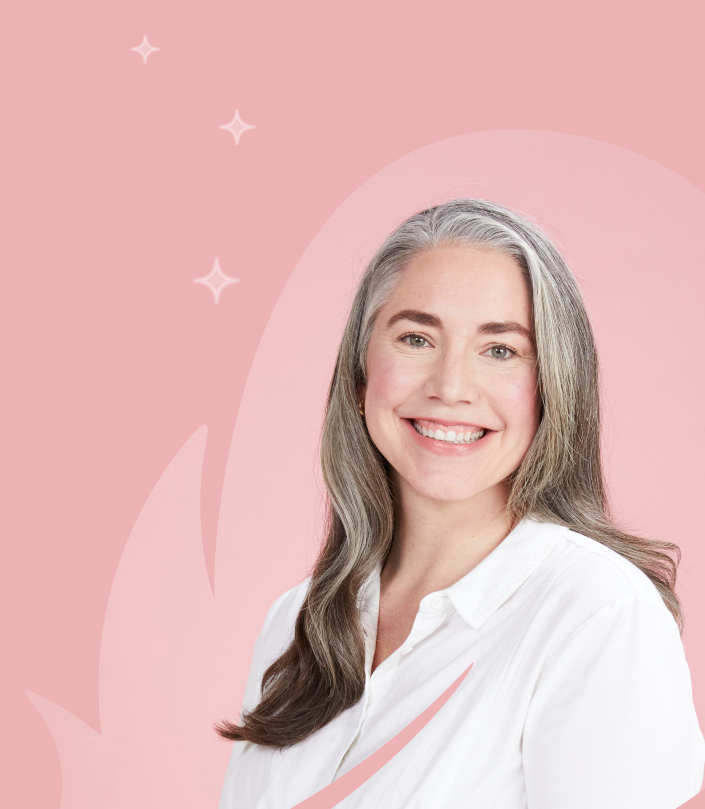A Flo expert helps you understand how to figure out your fertile window.
-
Tracking cycle
-
Getting pregnant
-
Pregnancy
-
Help Center
-
Flo for Partners
-
Anonymous Mode
-
Flo app reviews
-
Flo Premium New
-
Secret Chats New
-
Symptom Checker New
-
Your cycle
-
Health 360°
-
Getting pregnant
-
Pregnancy
-
Being a mom
-
LGBTQ+
-
Quizzes
-
Ovulation calculator
-
hCG calculator
-
Pregnancy test calculator
-
Menstrual cycle calculator
-
Period calculator
-
Implantation calculator
-
Pregnancy weeks to months calculator
-
Pregnancy due date calculator
-
IVF and FET due date calculator
-
Due date calculator by ultrasound
-
Medical Affairs
-
Science & Research
-
Pass It On Project New
-
Privacy Portal
-
Press Center
-
Flo Accuracy
-
Careers
-
Contact Us
Can you get pregnant two days after ovulation?


Every piece of content at Flo Health adheres to the highest editorial standards for language, style, and medical accuracy. To learn what we do to deliver the best health and lifestyle insights to you, check out our content review principles.
When you’re trying to conceive (TTC), it’s natural to wonder exactly when in your cycle you can get pregnant. Sex education classes at school may have made out that pregnancy can happen all too easily at any time, but the reality is a little more complex than that. So understanding what’s going on in your body when ovulation (the release of an egg) happens, and when that could ultimately lead to pregnancy, may help to remove some of the guesswork.
So, can you get pregnant two days after ovulation? We’ll take a deep dive into when you’re actually classed as being pregnant, the best time in your cycle for conceiving, and other useful tips if you’re TTC.
Key takeaways: Can you get pregnant two days after ovulation?
- When you ovulate, one of your ovaries releases a mature egg, which travels down your fallopian tube.
- If sperm are there waiting to meet it, the egg may be fertilized, and this may lead to pregnancy.
- For the best chance of pregnancy, you should aim to have regular unprotected sex inside your fertile window, which includes the five days before you ovulate and up to one day after. That’s because sperm can live inside you for five days, and the egg only survives for 12 to 24 hours after it’s released.
See a health care professional if you have any concerns about ovulation or your cycle. An app like Flo can help you track your cycles and symptoms so you can understand your normal and spot patterns, such as your body’s fertility signs.
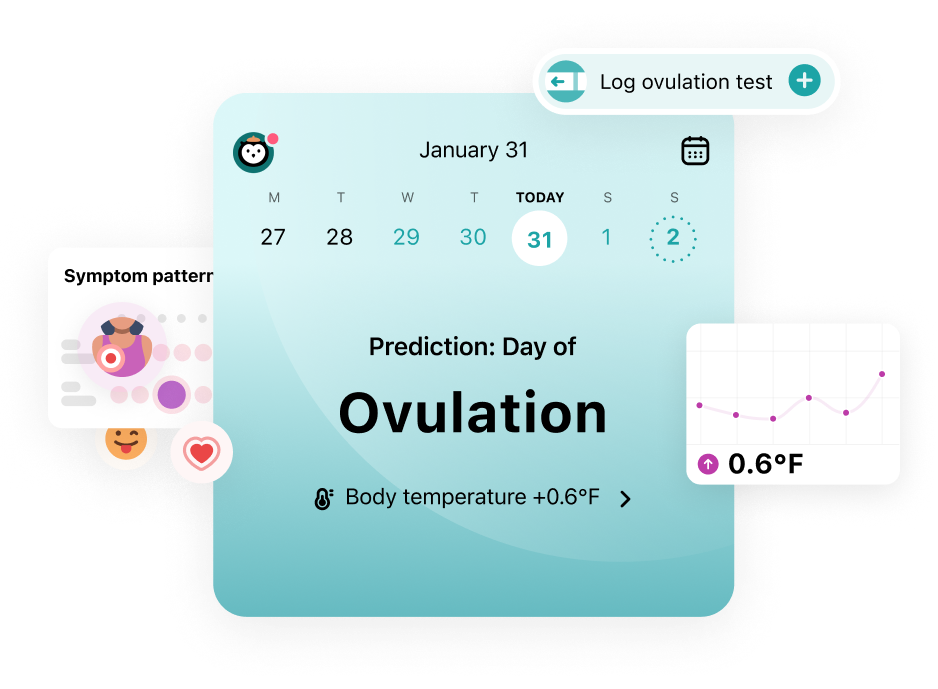
 Over
7.8M
ratings averaging
4.8/5
*
Over
7.8M
ratings averaging
4.8/5
*
Understand your fertility better with the Flo app
- Learn more about your fertility signals
- Improve ovulation predictions by tracking temperature via Apple Watch
- Log your ovulation test results
 Over
7.8M
ratings averaging
4.8/5
*
Over
7.8M
ratings averaging
4.8/5
*
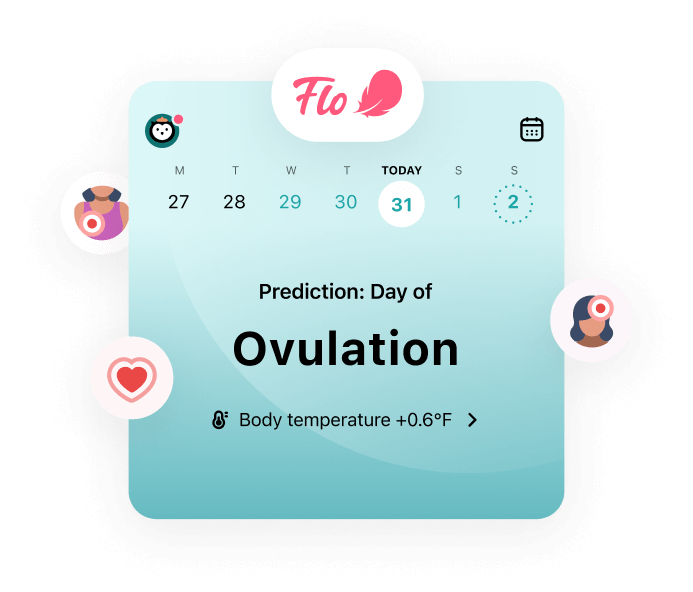
Trying to conceive?
The Flo app can help you better understand your fertility

 Over
7.8M
ratings averaging
4.8/5
*
Over
7.8M
ratings averaging
4.8/5
*
Understand your fertility better with the Flo app
- Learn more about your fertility signals
- Improve ovulation predictions by tracking temperature via Apple Watch
- Log your ovulation test results
How does ovulation work?
Ovulation is the time in your cycle when one of your ovaries releases an egg, which has matured after growing inside a little fluid-filled sac called a follicle. That egg then travels down your fallopian tube, where it’s possible for it to be fertilized by sperm. But there’s only a small window of time when that can happen because the egg can only survive for 12 to 24 hours once it’s been released.
After ovulation, your body starts producing the hormone progesterone to thicken the lining of your uterus, where the egg will need to implant if it’s been fertilized. If fertilization or implantation doesn’t happen, your uterine lining then sheds as your period, and your cycle starts again.
Can you get pregnant two days after ovulation?
Getting pregnant involves several steps, from having sex to getting that positive test result. But whichever stage you focus on, it’s not possible to get pregnant two days after ovulation.
The moment you conceive — which is when sperm fertilizes the egg in your fallopian tube — can only happen up to a maximum of 24 hours after you ovulate because your egg can’t survive any longer than a day after it’s released. “If you have unprotected sex [two days after ovulation], the egg is unlikely to be viable by the time sperm reach your fallopian tubes,” explains Dr. Sara Twogood, obstetrician and gynecologist, Cedars-Sinai Medical Group, California, US.
Conception is a huge deal, but it isn’t the same as being pregnant. Pregnancy only begins when the fertilized egg implants into the lining of your uterus, and it can take between six to 10 days to get from ovulation to implantation. So, if you’re looking at it like that, the earliest you could actually be pregnant is around six days after ovulation — not two days.
Things can get confusing if you think you’re ovulating on a certain day, but you actually ovulate a couple of days later. In that case, you could get pregnant two days (or any number of days) after your predicted ovulation. Even in very regular cycles, ovulation day can fall at slightly different times each month, which is why it’s useful to track ovulation. You can do that in a few different ways, which we’ll explain as you read on.

What is the chance of pregnancy after ovulation?
Pregnancy can happen after ovulation, but only for a limited time. Around 12 to 24 hours of being released, your egg will be reabsorbed back into your body, meaning your chance of getting pregnant will be over for that cycle.
But while pregnancy in the hours after ovulation is possible, it’s more likely if you have sex in the days that lead up to it. Sperm can survive inside your body for up to five days. This is why, as Dr. Twogood explains, “You’re most likely to conceive if sperm are already there when you ovulate, ready to fertilize the egg.”
One study looked at the average odds of getting pregnant from having sex on different days around ovulation. Here’s what the researchers found:
- Three days before ovulation, your odds of getting pregnant are 27%.
- Two days before ovulation, the likelihood is 33%.
- One day before ovulation is when you have the best chance to conceive. Women who have unprotected sex the day before they ovulate have around a 42% chance of pregnancy in that cycle, according to this study.
- The day you ovulate, you have a 20% chance of getting pregnant.
- One day after ovulation, the odds of conceiving fall to 8%.
- Two days after ovulation, there’s a 0% chance of getting pregnant because the egg has been reabsorbed.
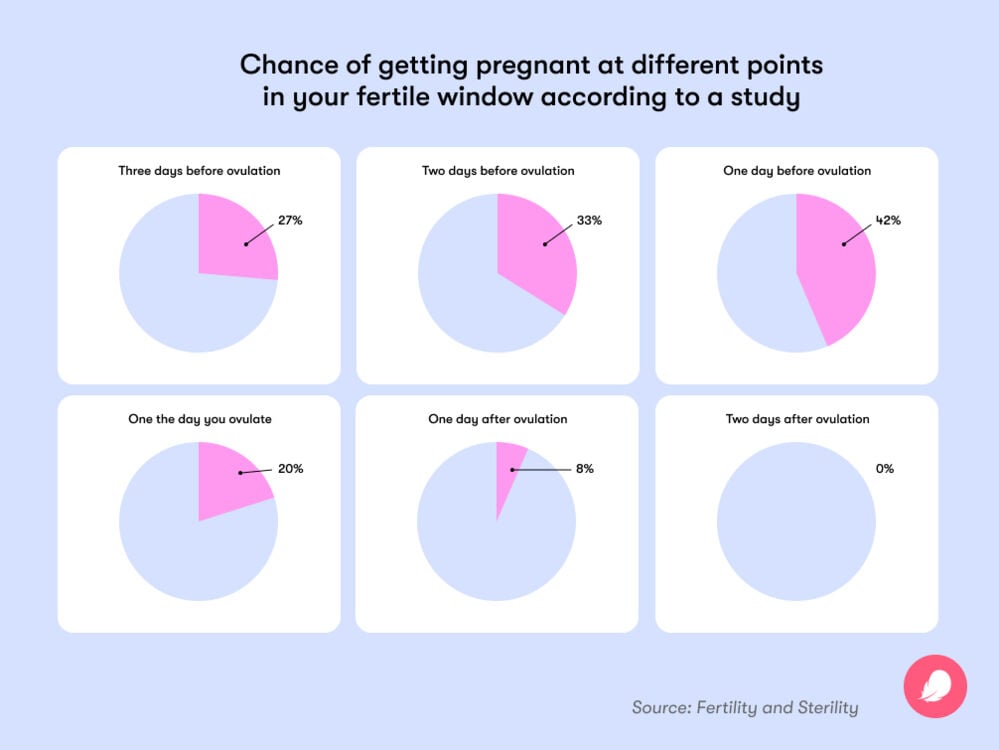
How to predict your ovulation days
A big part of getting pregnant relies on you correctly predicting your ovulation day each cycle. But, as Dr. Twogood points out, it isn’t always easy to get that right. “Even if you have regular cycles, you may not always ovulate on exactly the same day in every cycle, and anyone can have irregular ovulation from time to time,” she says.
“It’s helpful to know when you usually ovulate, as that tells you when you’re likely to be fertile in each cycle — but remember it’s an estimate,” adds Dr. Twogood. Ovulation-tracking methods can help to make this estimate a little more precise so you feel confident you’re making the most of your fertile window. You can try any of these ways to figure out when you’re ovulating:
Check your cervical mucus
A couple of days before ovulation, you might notice that your cervical mucus becomes stretchy and slippery — similar to raw egg whites. This is a sign you’re in the fertile phase of your cycle, but everyone is different, and some people might not notice it. Other possible physical symptoms of ovulation can include tender breasts, mild cramps, or bloating.
Try ovulation predictor kits
Ovulation tests detect the rise in luteinizing hormone that happens around 36 hours before your ovary releases an egg. To spot exactly when ovulation is about to happen, start testing your urine on the first day of your expected fertile window and keep going until you get a positive result. “If your cycles are irregular, ovulation predictor kits may still be helpful, but you’ll need to use more tests if your fertile window varies,” says Dr. Twogood.
Take a quiz
Find out what you can do with our Health Assistant
Monitor basal body temperature
Your temperature at rest — known as your basal body temperature — increases slightly after you ovulate by around 0.5ºF (0.3ºC). If you track your temperature regularly using a special digital thermometer, you may be able to spot the rise. It’s worth noting, though, that this method can’t tell you in advance when you’re about to ovulate, only afterward.
Use a tracking app to log your cycle dates and symptoms
A period-tracking app like Flo can make it easier to monitor your cycle dates and symptoms, helping you understand your body’s fertility signals better.
Frequently asked questions about the chance of pregnancy after ovulation
How do you know if you ovulated?
The best way to know if you ovulated is to see if you either have a period or a positive pregnancy test about two weeks later. However, your body may give you a few subtle signs to know sooner that ovulation has already occurred. Your basal body temperature can rise, but you’ll need to regularly track your temperature at rest to spot the subtle difference. Some people notice mild cramping in the pelvic area around ovulation (called mittelschmerz), and you may find your vaginal discharge loses the egg white consistency and becomes thicker and stickier after ovulation.
When should you have sex to conceive?
Studies show your best chance of getting pregnant comes from having unprotected sex every day or every other day during your fertile window. That’s the six days up to and including the day of ovulation. Since sperm can live in your body for up to five days, they’ll be ready and waiting to fertilize the egg whenever it’s released.
Can you know if you’re pregnant two days after ovulation?
The two-week wait before finding out you’re pregnant can often feel frustrating, so it would be great not to have to go through it. But the truth is, it’s not possible to notice early signs of pregnancy just two days after ovulation. In fact, you’re not officially pregnant until the fertilized egg implants, around six to 10 days after ovulation. Even then, you won’t know you’re pregnant until your body starts making the pregnancy hormone human chorionic gonadotropin (hCG), which is detected in pregnancy tests. You’ll need to wait for about two weeks after ovulation for hCG levels to be high enough to be picked up on a pregnancy test. If you find the wait difficult, try to distract yourself with relaxing activities and share your feelings with loved ones if it helps.
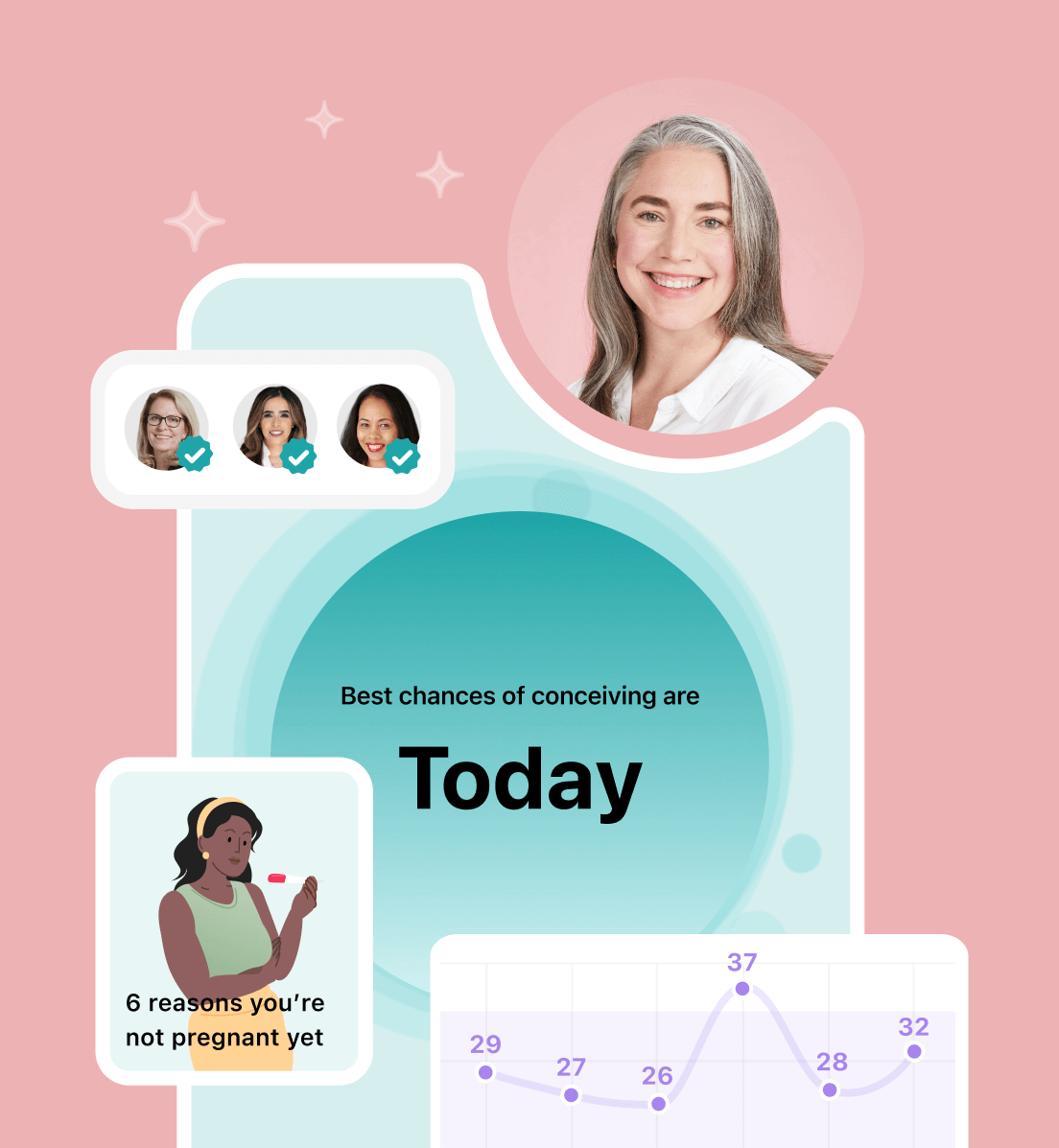
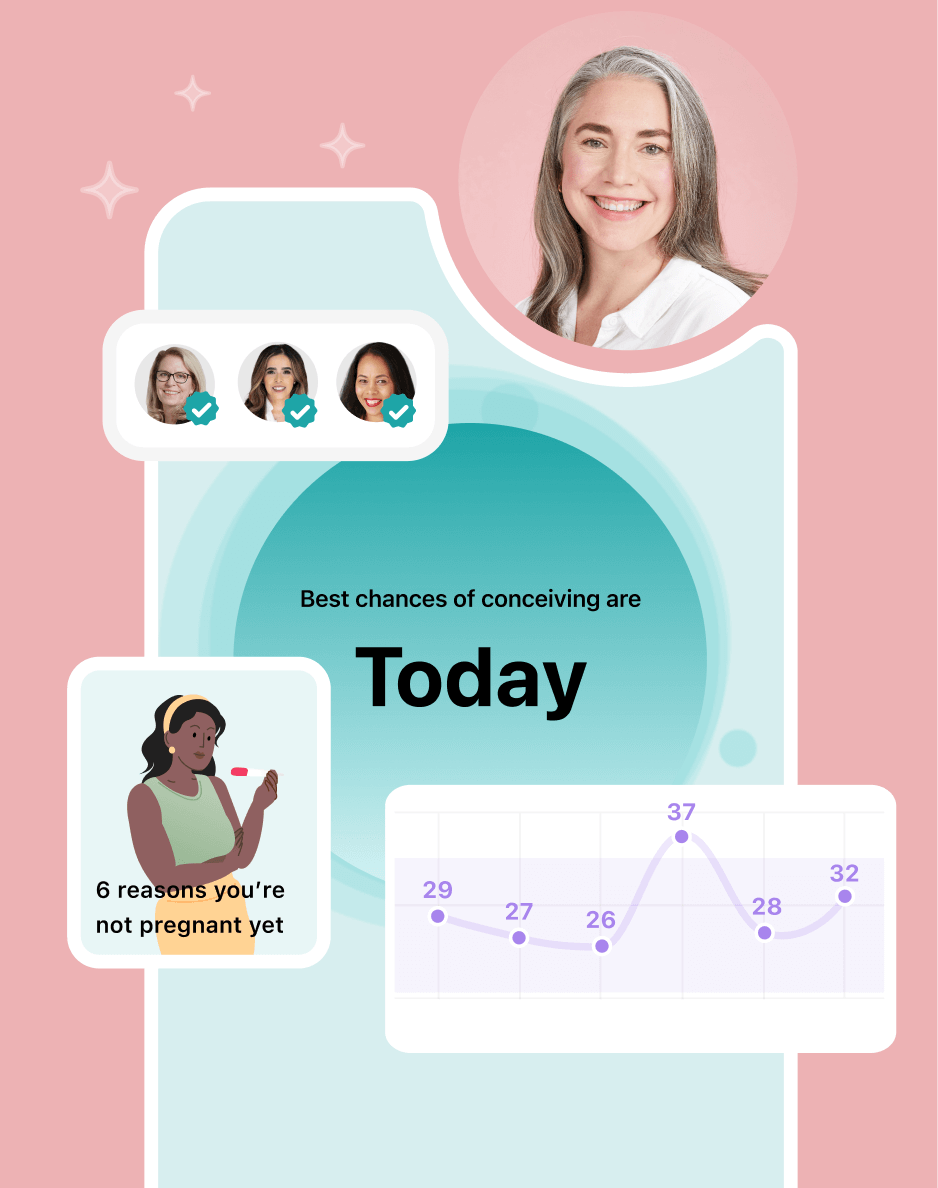
Hey, I'm Anique
I started using Flo app to track my period and ovulation because we wanted to have a baby.
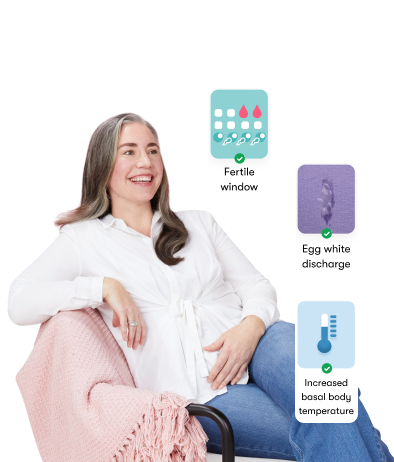
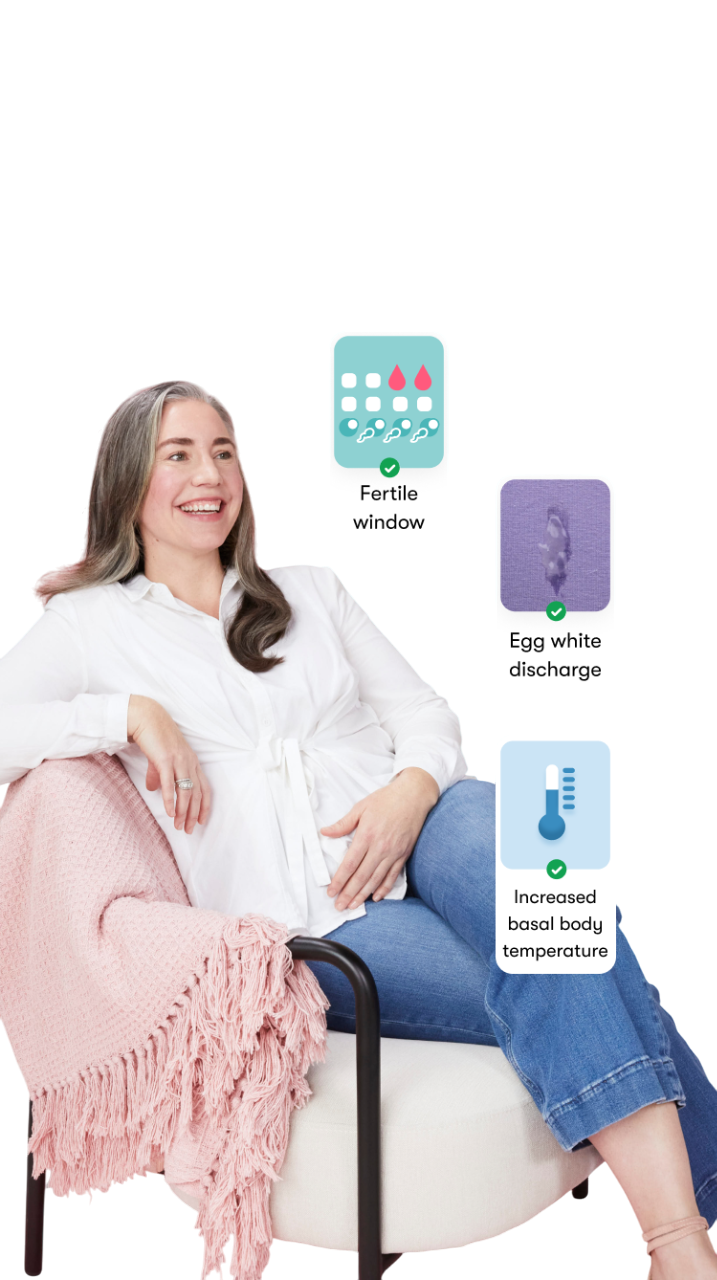
The Flo app helped me learn about my body and spot ovulation signs during our conception journey.
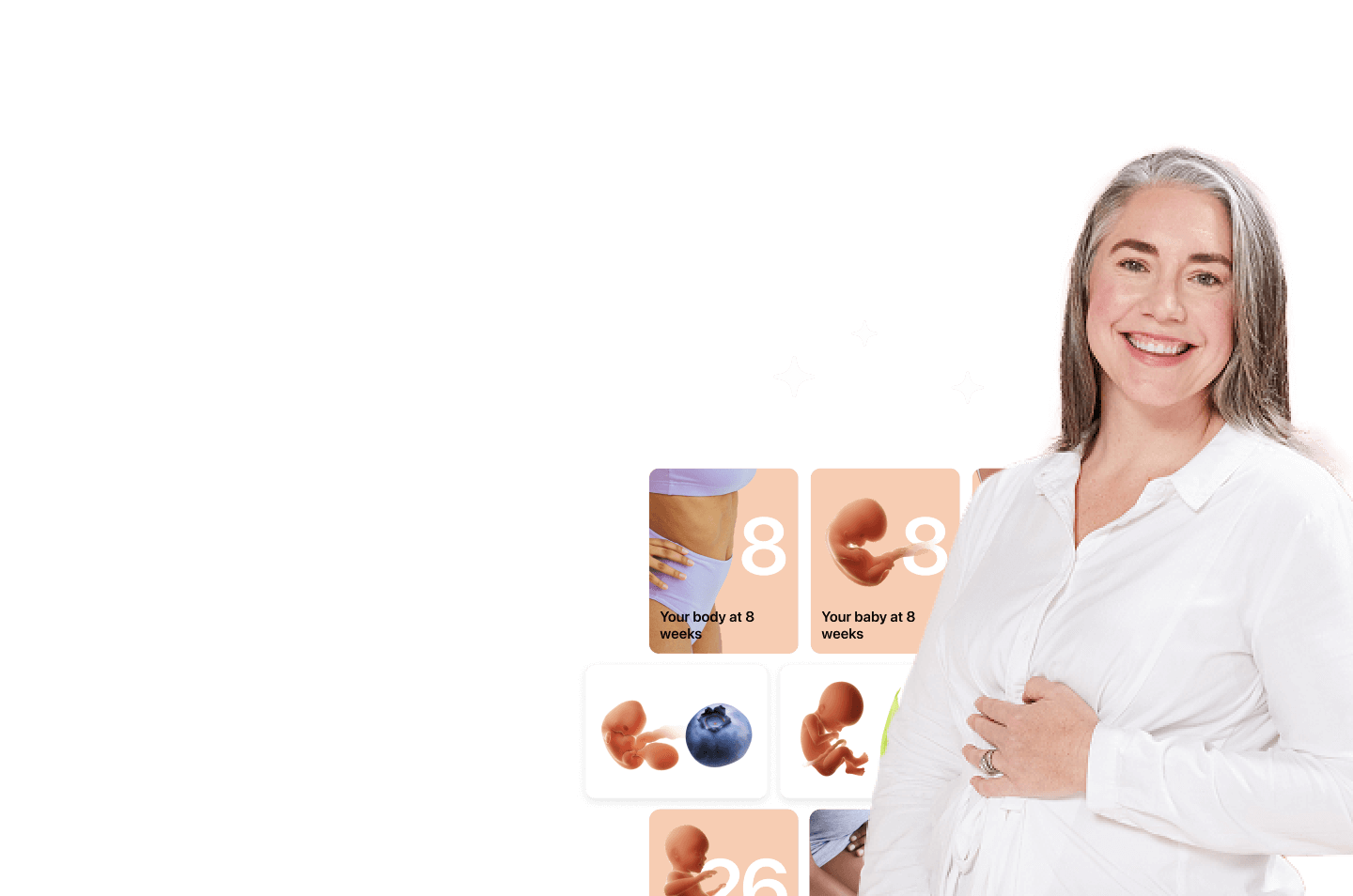
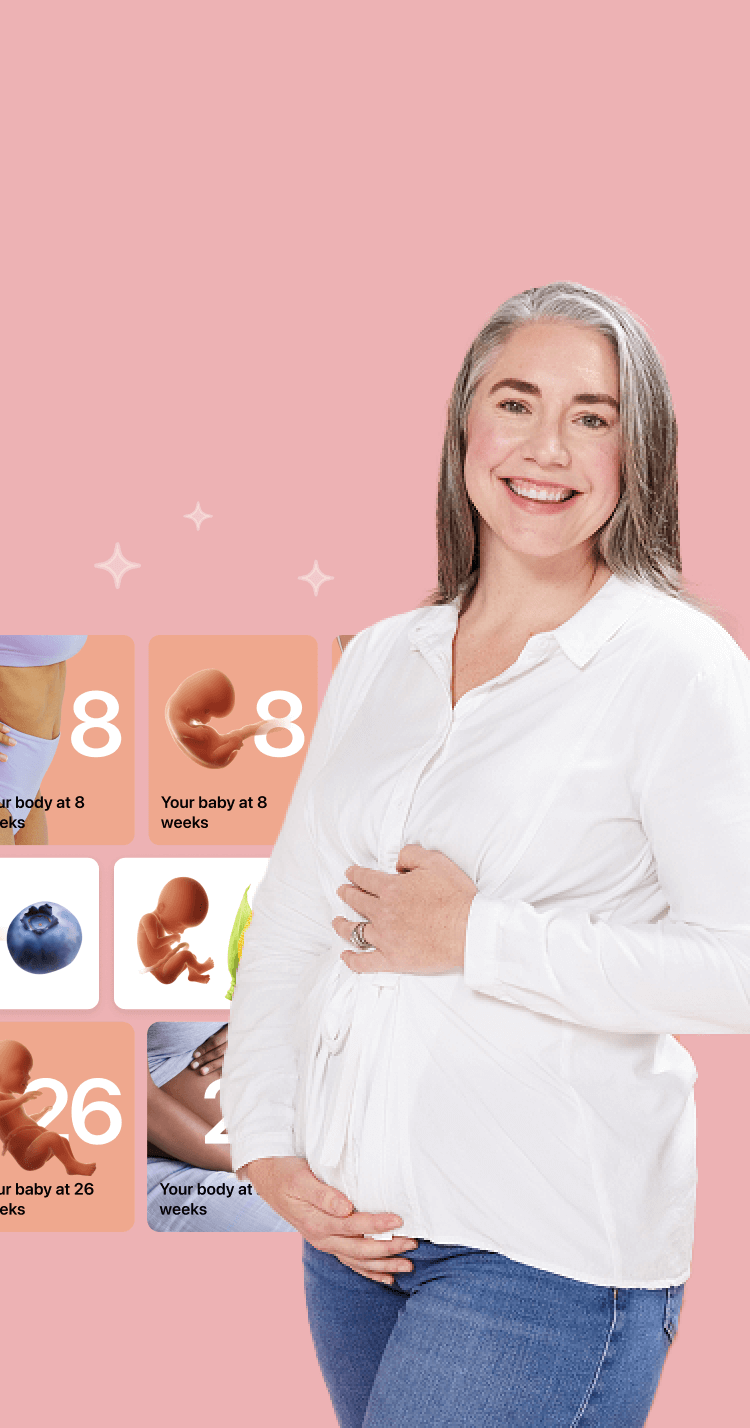
I vividly
remember the day
that we switched
Flo into
Pregnancy Mode — it was
such a special
moment.
Real stories, real results
Learn how the Flo app became an amazing cheerleader for us on our conception journey.
References
“Breast Pain (Mastalgia).” Johns Hopkins Medicine, www.hopkinsmedicine.org/health/conditions-and-diseases/mastalgia-breast-pain. Accessed 10 Jan. 2025.
“Cervical Mucus.” Cleveland Clinic, my.clevelandclinic.org/health/body/21957-cervical-mucus. Accessed 20 July 2022.
“Conception.” Cleveland Clinic, my.clevelandclinic.org/health/articles/11585-conception. Accessed 23 Sep. 2022.
“Conception: How It Works.” UCSF Health, www.ucsfhealth.org/education/conception-how-it-works. Accessed 10 Jan. 2025.
Faust, Louis, et al. “Findings from a Mobile Application-Based Cohort Are Consistent with Established Knowledge of the Menstrual Cycle, Fertile Window, and Conception.” Fertility and Sterility, vol. 112, no. 3, Sep. 2019, pp. 450–457.e3, doi:10.1016/j.fertnstert.2019.05.008.
“Fertility Awareness-Based Methods of Family Planning.” The American College of Obstetricians and Gynecologists, Jan. 2019, www.acog.org/womens-health/faqs/fertility-awareness-based-methods-of-family-planning.
“Finding Your Fertility Window.” Mayo Clinic Press, 3 May 2024, mcpress.mayoclinic.org/pregnancy/finding-your-fertility-window/.
“How Soon Can You Tell You’re Pregnant?” Cleveland Clinic, 28 Sep. 2022, health.clevelandclinic.org/how-early-can-you-tell-if-you-are-pregnant.
“How to Get Pregnant.” Mayo Clinic, 30 Oct. 2024, www.mayoclinic.org/healthy-lifestyle/getting-pregnant/in-depth/how-to-get-pregnant/art-20047611.
“Human Chorionic Gonadotropin.” Cleveland Clinic, my.clevelandclinic.org/health/articles/22489-human-chorionic-gonadotropin. Accessed 12 Aug. 2022.
“Ovulation.” Cleveland Clinic, my.clevelandclinic.org/health/articles/23439-ovulation. Accessed 17 Feb. 2023.
“Ovulation Pain.” Cleveland Clinic, my.clevelandclinic.org/health/diseases/9134-ovulation-pain-mittelschmerz. Accessed 15 Aug. 2024.
“Pregnancy Tests.” Cleveland Clinic, my.clevelandclinic.org/health/diagnostics/9703-pregnancy-tests. Accessed 10 Jan. 2025.
“Progesterone.” Cleveland Clinic, my.clevelandclinic.org/health/body/24562-progesterone. Accessed 8 Nov. 2024.
Su, Ren-Wei, and Asgerally T. Fazleabas. “Implantation and Establishment of Pregnancy in Human and Nonhuman Primates.” Advances in Anatomy, Embryology, and Cell Biology, vol. 216, 2015, pp. 189–213, doi:10.1007/978-3-319-15856-3_10.
“What Ovulation Signs Can I Watch for if I Want to Get Pregnant?” Mayo Clinic, 9 July 2024, www.mayoclinic.org/healthy-lifestyle/getting-pregnant/expert-answers/ovulation-signs/faq-20058000.
Wilcox, Allen J., et al. “Timing of Sexual Intercourse in Relation to Ovulation: Effects on the Probability of Conception, Survival of the Pregnancy, and Sex of the Baby.” The New England Journal of Medicine, vol. 333, no. 23, Dec. 1995, pp. 1517–21, DOI: 10.1056/NEJM199512073332301.
Witt, Barry. “Trying to Get Pregnant? Here’s When to Have Sex.” The American College of Obstetricians and Gynecologists, Aug. 2023, www.acog.org/womens-health/experts-and-stories/the-latest/trying-to-get-pregnant-heres-when-to-have-sex.
History of updates
Current version (21 January 2025)
Published (21 January 2025)
In this article
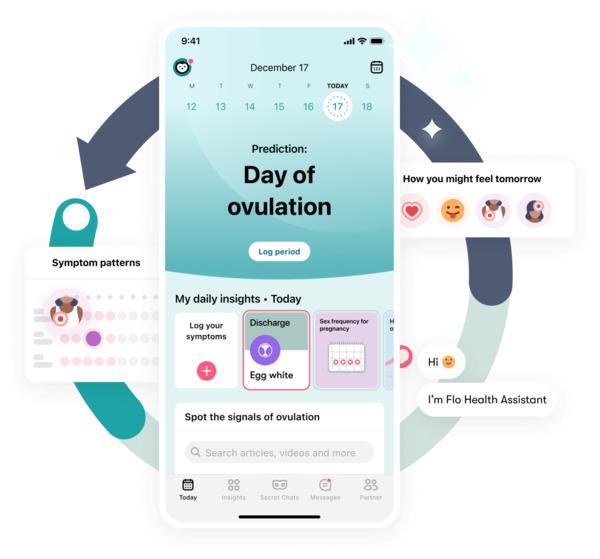
Get your personal guide to fertility
-
Learn how to read your body's ovulation signals
-
Find daily conception tips from our experts
-
Chat with others who are trying to get pregnant



